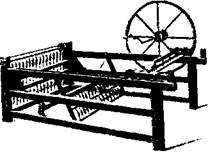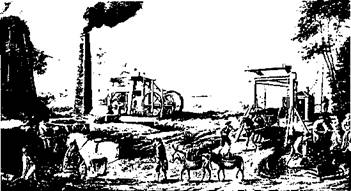home
 Economy Economy
 Books Books
 History of the world economy - Polyak GB History of the world economy - Polyak GB
|
History of the world economy - Polyak GB
19.2. England - the birthplace of the industrial revolution
Already in the XVII century. England began to overtake the world leader - Holland first in terms of the growth of capitalist manufactories, and later in world trade and the colonial economy. By the middle of the XVIII century. England becomes the leading capitalist country. On the level of economic development, it surpassed the rest of the European countries, having all the necessary prerequisites for entering the new stage of socio-economic development - large-scale machine production.
Agriculture
In the XVIII century. England continued to remain predominantly an agricultural country. After the bourgeois revolution of the middle of the XVII century. The process of ousting small and medium-sized peasant farms with large-scale landed property resulted in the mid-18th century. To the fact that the peasantry as a class has left the historical arena. As a result of the destruction of communal and small peasant farming, there was a redistribution of landed property, the growth of large land ownership and the development of capitalist farming.
Enlargement of estates allowed landlords to use agricultural machines (seeders, threshers, etc.) more widely. Agricultural technology and agriculture were improved. The transition to an improved fruit-rotated crop rotation has been outlined. Capitalism, with the involvement of hired workers, using more advanced equipment and paying capitalists rent to the landowners, led the economy and large farmers.
A steady stimulus for improving production was the steady demand for agricultural products and the steady expansion of both domestic and foreign markets.
Now scientific methods of work have been increasingly used. Four-year rotation and alternation of various crops-cereals, root crops, grasses, deeper plowing and thorough loosening of the soil, control of weeds, use of organic fertilizers, etc. were introduced. The achievements in livestock raising became more appreciable. The stall maintenance of cattle, sheep, about their more complete winter feeding, etc., went into practice.
It is clear that such innovations required significant investment. Now the former fencing was not limited to turning arable land into pasture for sheep. Fencing in the XVIII century. Was the creation on the basis of jointly cultivated land open fields of large farms. To the general consolidation of plots and the replacement of small tenants, the growth of rents was also greater. Her size sometimes exceeded the usual fee by four to ten times. The breadth of fences carried out is evidenced by an increase in the number of relevant acts passed through the English Parliament during the 18th century. If in the first quarter of the century there were 15, by the middle of the century more than 220, at the end of the century almost 1.5 thousand became. With the adoption of the law (1800) on the transformation of communal ownership of peasants into private ownership of landlords, the fencing process in the 18th century. Was completed.
Thus, agricultural production in England in the XVIII century. Developed at a higher level. Significantly increased its marketability. More fully satisfied with the growing demand of non-agricultural population for food, and industry - for raw materials. In turn, the fencing formed additional reserves of free labor for its wider use in industrial production.
Preconditions of industrial revolution
As already noted, the bourgeois revolution in the middle of the 17th century afforded wide scope for the country's economic progress. It eliminated obstacles to capitalist development. Approved the bourgeois ownership of the land. Accelerated the formation of the national market. A stable union of the land and financial aristocracy, led by the monarchy, has been established in the country. Among the factors that stimulated the development of industrial production at a higher level and the rise of inventive thought, the following can be named.
In the XVIII century. The manufacturing system has become obsolete and has reached a dead end in the most developed branches of British industry. The technical basis of the manufactory has come into conflict with its own created needs of production and the demands of the domestic and foreign markets. A new technical base corresponding to capitalist production was needed.
New requirements for training were put forward. Qualified working cadres were formed at the operating manufactories in the division of labor operations. And the inventive idea was based on the creation of mechanical devices for their implementation. The preparation of scientific and technical personnel was given considerable attention at the universities of Glasgow and Edinburgh, the Royal Institute in London, as well as in real secondary schools in the industrial centers of the country.
The trade and industrial elite that stood in power in alliance with the "new nobility" determined the economic policy of the state in the capitalist direction. The current policy of protectionism introduced high import duties on foreign goods. Faced with the world market with products from Russia, Sweden, India (cotton fabrics, metal, etc.), England could beat competitors, only by creating factory production and setting the output of more competitive products - high-quality and inexpensive.
England managed to accumulate a sufficient amount of free capital to subsidize scientific research and practical introduction into production of technical inventions and improvements. The source of the necessary funds was also the public debt, and the growth of taxation, and expansion of production and trade. Trade wars of the XVIII century. For England almost always accompanied by the seizure of new colonies. So, in the XVIII century. England took part in 120 colonial conflicts. The completion of the formation of a huge British colonial empire was the Seven Years' War (1756-1763). Having gained a victory in it, England turned into a mighty power, displacing France from India, capturing Canada. Under the auspices and with the military support of the British government was the largest East India Company. True, there were losses. A serious blow to British colonial rule was the War of Independence of the North American Colonies (1775-1783) and the formation of the United States (1776). Indeed, the British bourgeoisie has accumulated enormous funds through the robbing of the colonies. Here goods from the metropolis sold at monopolistically high prices. And colonial goods were sold for a pittance. Great income was received by England and from the slave trade, annually exporting to America about 20 thousand Negroes.
All this enabled England to become the birthplace of an industrial revolution.
Directions and consequences of industrial revolution
An industrial revolution is the transition from a manufactory with a manual division of labor to factory production, accompanied by the formation of an industrial bourgeoisie and an industrial proletariat. In England, he embraced the second half of the XVIII - the first quarter of the XIX century. And had several directions.
The coup began in the textile industry and, above all, in cotton. Pressing expensive cloth, cotton fabric, made with the help of new machines, became cheaper and of high quality. It was she who was able to provide both her own significant demand and drive out competitors in the world market.
At first, improvements and inventions affected weaving. In the 30-ies. XVIII century. Mechanic J. Kay created a "flying shuttle", doubling the productivity of labor. This machine was driven by a weaver using a cord and a block. In the 80's - early 90's. E. Cartwright created several models of a mechanical loom. Its use made it possible to exceed the productivity of a hand-held machine by 40 times.
At the same time there was a perfection of spinning. In 1765 the weaver and carpenter J. Hargreaves created a wooden spinning wheel "Jenny", named after his daughter. It was a kind of combination of a spinning-wheel and a stretching press that released the worker's hand for simultaneous work at 8.16 first, and then 80 or more spindles. She gave, though a thin, but fragile thread. T. Hais' water tank (1767), driven by water, gave a strong but thick thread. Mul machine S. Crompton (1779), combining the advantages of the first machines, had already 400 spindles and spun a thin and strong thread.

Spinning machine "Jenny"
Chemist K. Berthollet (1785) applied chlorine during bleaching of the canvas, T. Bell suggested coloring the tissues with a rotating roller with a cut out on it pattern.
The steady increase in the production of cars has revealed the next direction of the industrial revolution - the improvement of the metallurgical process. Thus, the engineer A. Derby began to add to the iron ore, instead of wood charcoal and quicklime (1735), to obtain high-quality cast iron during melting. G. Court received a patent for converting cast iron into a low-carbon, dough-like iron-pudding (1784).
There was a peculiar close chain of mutual stimulation of the country's industrial development. Demand for hard coal accelerated the development of the coal industry - cast iron smelting and coal mining increased fourfold. This, in turn, pushed transport construction, including water, which significantly reduced transportation costs. Meanwhile, a wide transportation network contributed to the growth of domestic trade, which led to the accumulation of capital and stimulated further expansion of production.
Unlimited prospects for the machine industry and a significant increase in industrial production were associated with the third direction of the industrial revolution. The creation of the steam engine satisfied the objective need for a universal and more efficient engine. The Scottish laboratory assistant J. Watt for nearly 10 years (1774-1784) perfected the steam engine. This steam engine has found wide application in both manufacturing and transport. In particular, the use of these machines in cotton production tripled the output of fabrics. In 1800 there were 320 steam engines in England, and by the first quarter of the 19th century, - already 15 thousand.

Watt Steam Machine

The coal mines in England with steam-powered devices
The final stage of the industrial revolution was the creation of an engineering industry in England . New methods of metal processing allowed the production of standard parts of machines and mechanisms. The end of the industrial revolution was the beginning of the process of manufacturing machines with machines. In 1794, G. Models designed the first metalworking machines. Then there were presses, hammers, etc.
Industrial revolution in England affected not only industry. He touched all spheres of production, including agriculture, caused the growth of cities and urban population. All the aspects of life and everyday life of the population experienced profound influence. The appearance of the country was changed. This was the beginning of the formation of a new industrial civilization. In cities, 40% of the population already lived. The largest city in the world was London with a population of more than 0.5 million people, mainly employed in industry, commerce and shipping. Here, the main foreign trade and financial transactions were carried out. It was a kind of trans-shipment point in overseas trade, replacing Amsterdam in this role.


Comments
Commenting on, remember that the content and tone of your message can hurt the feelings of real people, show respect and tolerance to your interlocutors even if you do not share their opinion, your behavior in the conditions of freedom of expression and anonymity provided by the Internet, changes Not only virtual, but also the real world. All comments are hidden from the index, spam is controlled.